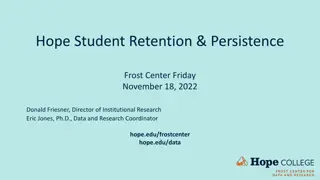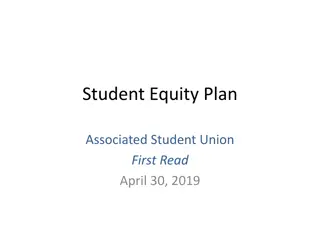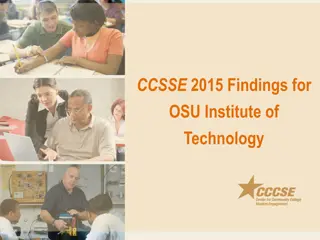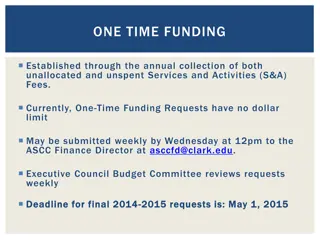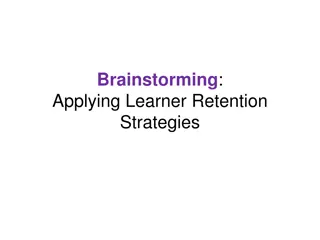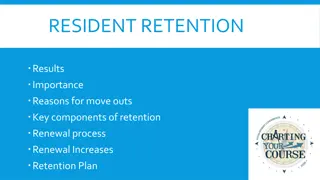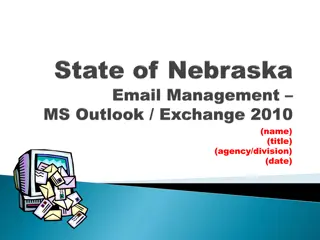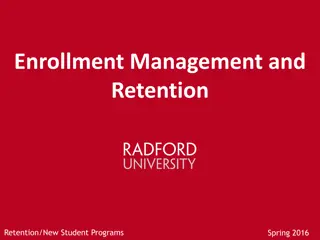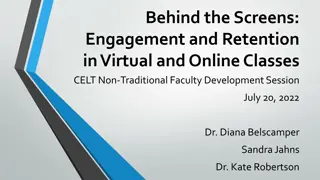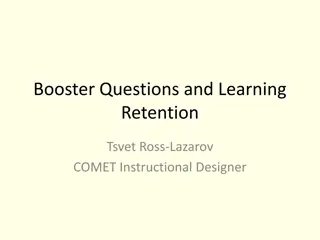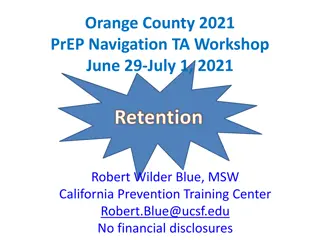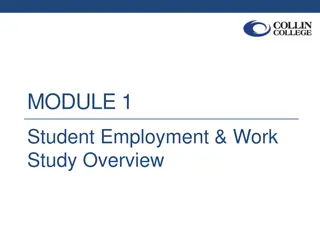Strategies for Enhancing Student Retention in College
Explore student retention strategies based on provincial rates, factors influencing retention, and interventions like academic advising and social connectedness. Discover insights on program approaches, study habits, peer engagement, and more to support students' pathways to completion.
Download Presentation

Please find below an Image/Link to download the presentation.
The content on the website is provided AS IS for your information and personal use only. It may not be sold, licensed, or shared on other websites without obtaining consent from the author.If you encounter any issues during the download, it is possible that the publisher has removed the file from their server.
You are allowed to download the files provided on this website for personal or commercial use, subject to the condition that they are used lawfully. All files are the property of their respective owners.
The content on the website is provided AS IS for your information and personal use only. It may not be sold, licensed, or shared on other websites without obtaining consent from the author.
E N D
Presentation Transcript
Student Retention Strategies
Provincial Retention Rates 2016-17 Approach Provincial Retention Rate Provincial Success Rate College-Delivered at College 87% 91% College-Delivered at Secondary School 86% 94% College-Delivered Level 1 at College 93% 83% Taught by Secondary School Teacher with Oversight 90% 77% Team-Taught at College 88% 93% Team-Taught at Secondary School 92% 94%
Factors Influencing Retention Academic Advising Social Connectedness & Engagement Faculty and Staff Approachability Business Procedures Learning Experience Student Support Services Hanover Research. (September 2014). Strategies for Improving Student Retention. Retrieved from https://www.hanoverresearch.com/media/Strategies-for-Improving- Student-Retention.pdf, pg. 8-9.
Academic Advising Influences: Different program approaches (e.g. on campus vs. off campus, congregated vs. integrated vs. team-taught) Student study habits and lack of understanding of college assessment Lacking resources for dealing with the challenges of completing a college course Student seeing their pathway after their dual credit Strategies: Admissions process (e.g. guidance counsellor and college) Dual credit teacher (e.g. importance of handing in assignments) College instructor After Adult Dual Credit (ADC) and School within a College (SWAC) activities Dual credit orientations led by the college describing expectations (provided on the SLC DC website and orientation hand outs)
Social Connectedness and Engagement Influences: Students dynamics - the fear of meeting new students Engagement with peers in class and a sense of belonging Working toward a common goal Student cannot find a classroom feels socially isolated and alienated Type of program (on-campus vs. off campus) Strategies: Comfortable contact person Making contact with the students as a Dual Credit Facilitator and Dual Credit teacher 2-3 times before course begins (e-mail, text, phone call) SWAG item to identify the group Attending Dual Credit orientation with college tour Orientation attendance Emphasis on class attendance Mitigate a plan of action if an absence does occur Instructor engagement with students
Social Connectedness and Engagement Program Specific Grade Distribution Fall 2012-Winter 2017 (n=2570) 400 350 300 250 200 150 100 50 0 50-59% 60-69% 70-79% 80-89% 90-100% Team-Taught Integrated Congregated OYAP
Faculty and Staff Approachability Influences: Connectedness to course and instructor (does the student feel comfortable communicating with their instructor) Class size Student more likely to ask questions and for help when needed if they feel comfortable with staff and faculty Disappearing students Strategies: Providing adequate contact information Offering adequate office hours and other opportunities for interaction Dual credit teacher liaises communication with student and instructor Class size can help positively influence student retention (not too large so students can connect to peers and faculty) (Hanover Research, 2014) Students who engage with faculty and staff are more likely to persist to graduation (Hanover Research, 2014)
Business Procedures Influences: Students are less likely to finish if they have unhelpful or unpleasant experiences with the institution (e.g. how to get an accommodation letter with their IEP from the college) When business procedures become barriers Strategies: E-mails and information about programming from the college (e.g. schedule, timelines, orientations, contact information) Logging into college e-mail and Blackboard (academic user system at St. Lawrence College) at orientation Availability to usernames for college Set and standardize college procedures for admissions, IEPs, transportation, website, obtaining their student number/card Feedback from school boards and dual credit teachers to college
Learning Experience Influence: The classroom is where students interact with their peers and faculty (especially important as students are not engaging in other campus activities) Course curriculum Students may have preconceived notions that college is too difficult or feel under challenged Students receiving support when needed from the college (e.g. counselling, student success facilitators, math and writing help, tutors) Strategies: Emphasis on the student communicating with the course instructor Importance of program choice of the student and by the college (e.g. introductory courses help positively influence student retention) Course instructor must describe course expectations, assessment, provide feedback and support students if there is lack of understanding with an assignment Ensure students know there are supports available at the college and from home school, guidance counsellor, student success facilitators, math and writing help, tutors etc. Course choice through RFP
Student Support Services Influences: Student persistence and mental wellness Life issues: Insecurity about financial circumstances, job and school time conflicts, home and family difficulties, personal problems etc. Strategies: Assist with student persistence and mental wellness Discussion of access to student support services at the college (math and writing, counsellors, AccessAbility services, Dual Credit teacher) Dual Credit Facilitator at the college also main contact while at the college for support Emphasis on self-advocacy at orientation Direction to community resources
Factors Influencing Retention Academic Advising Social Learning Experience Connectedness & Engagement Faculty/Staff Approachability Student Support Services Business Procedures
Case Studies Jill & Jake Strategies & Discussion Academic Advising Make sure the course outline was described in detail Figure out the real reason for dropping or wanting to drop Build check-in points with students/check attendance Dual Credit teacher/Guidance Counsellor or if more connected to college instructor Did the student get to the orientation where the student was connected to college/Dual Credit contacts Touch base to inform it s not too late to recover the course Prioritize the class to reduce stress Sharing info from the college Create a plan and team (i.e., guidance, parents, student instructor) for success
Case Studies Jill & Jake Strategies & Discussion Social Connectedness & Engagement Attendance Friends in class (made new friends) Discussion board for students Why did or is the student signing up for the course (e.g. because a friend signed up what if friend drops) Chunk timelines and bring gratification earlier (5 weeks) to keep students connected Have multiple communications with the students (e.g. email, call, and text) Liaise with students before course beings
Case Studies Jill & Jake Strategies & Discussion Faculty/Staff Approachability Engagement with instructor Instructors reflections Hand-in rate of assignments etc. Was the student vetted correctly by the school board Did the student have the potential to succeed Call to ensure life is okay, then tackle the academics
Case Studies Jill & Jake Strategies & Discussion Business Procedures Did the student attend orientation? Options if student drops or stays in course Is the student connected and knows who their Dual Credit teacher is? Have students refer back to course outline to see work needed to be completed Ensure there is a good model of support between the college and the high school Use the Remind App for students
Case Studies Jill & Jake Strategies & Discussion Student Support Services Mental Health Family/Financial Issues Determine if the student is at risk Set up a meeting with the student and the instructor Referral to student success at the college to keep with possible problems
Case Studies Jill & Jake Strategies & Discussion Learning Experience Is the student engaged Is the curriculum engaging Differentiating curriculum/assessment Student may feel they are doing poorly in the class At the beginning of the course have a social, get students to break out in their groups (e.g. ice breakers) Facilitate a relationship with another student in the class, low risk activities, focus on the student s well being
Provincial Retention Rates 2016-17 Successful Strategies Approach Vincent Tinto (2007) states that the degree to which a student interacts with academic and social communities at a post-secondary institution is correlated to retention. Provincial Retention Rate Provincial Success Rate College-Delivered at College 87% 91% College-Delivered at Secondary School 86% 94% College-Delivered Level 1 at College Theory & Practice, 8(1), 1-19. 93% 83% Tinto, V. (2007). Research and practice of student retention: What next? Journal of College Student Retention: Research, Taught by Secondary School Teacher with Oversight 90% 77% Team-Taught at College 88% 93% Team-Taught at Secondary School 92% 94%




